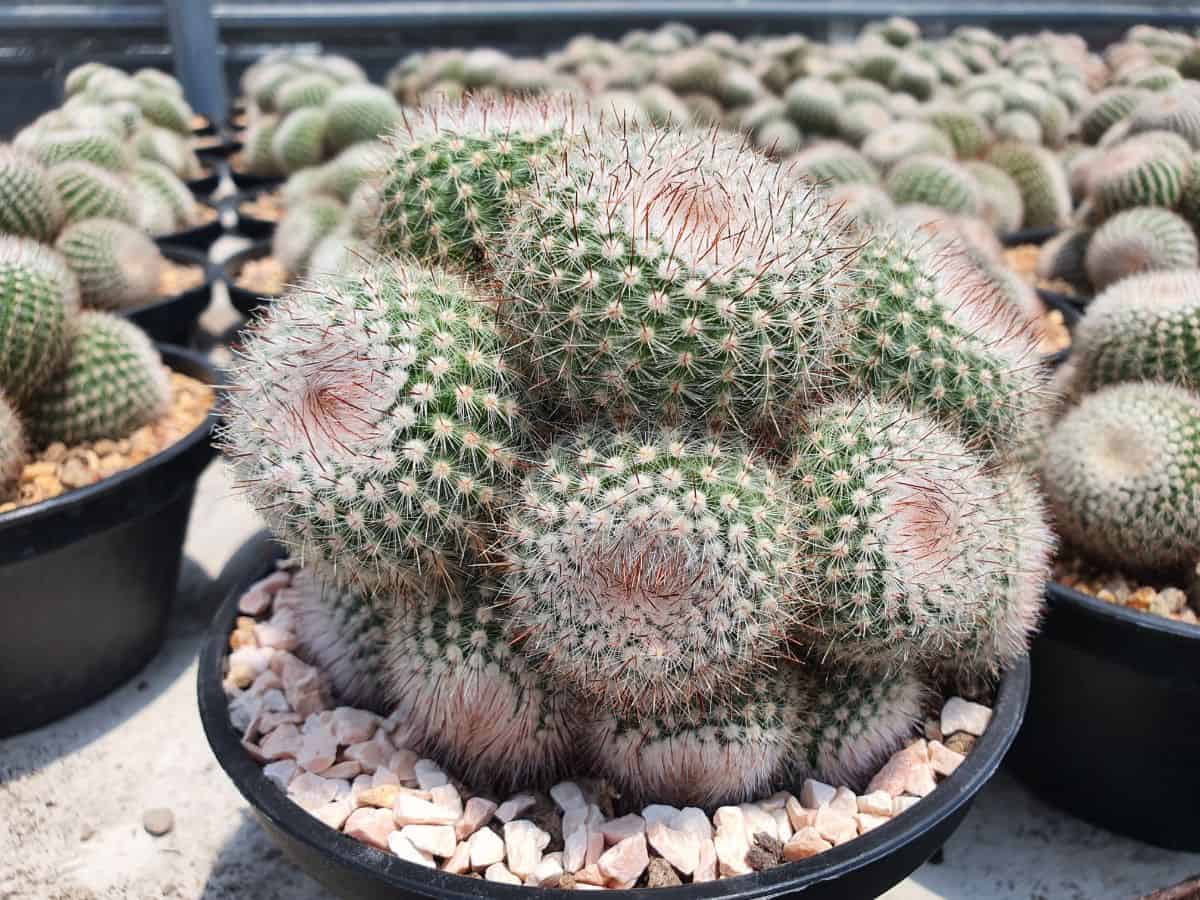
Notocactus, now known as Parodia, is a genus of flowering cacti native to South America. The habitat of Notocactus includes parts of Argentina, Bolivia, Brazil, Colombia, Peru, and Uruguay. In total, there are about 50 species of Notocactus, though not all are grown in cultivation.
The genus has been recently renamed after Domingo Parodi, who was one of the early researchers of Paraguay’s plant life.
Jump to:
Notocactus Appearance
| Name: | Notocactus |
| Soil: | Soil that drains quickly |
| Blooming: | Spring and summer |
| Light: | Full sun |
| Water: | Dry out before watering |
| Propagation: | Offsets,cuttings and seeds |
Since this genus contains so many species of cacti, there is some variation in appearance. In general, these cacti are branchless and range in shape from globose to columnar. The largest species measure about three feet in height at maturity.
Members of Notocactus, or Parodia, are deeply ribbed cacti with plenty of sharp spines along their ribs. They tend to produce single flowers near their crown when in bloom. Some species, though not all, will also produce offsets around their base.
Common Species of Notocactus
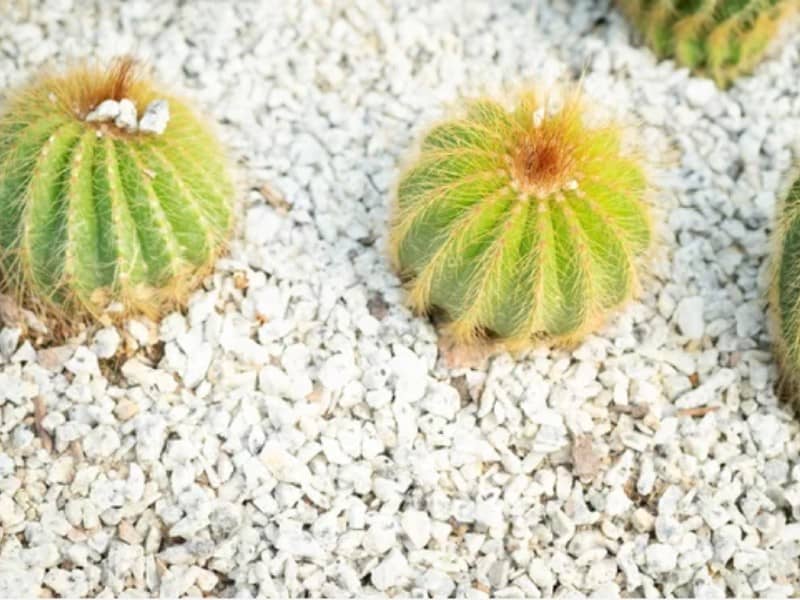
Buy it from:
Though there are around 50 species of Notocactus, not all are grown in cultivation. A few species are especially popular with cactus lovers around the world due to their simple shape and easy care.
Due to the name change of this genus, most species have more than one name that they may be recognized by.
Notocactus magnificus or Parodia magnifica
Parodia magnifica, previously known as Notocactus magnificus, is also sometimes called the Balloon Cactus due to its shape. This species is a deep bluish-green in color with yellow or gold spines along its 11 to 15 ribs.
At maturity, the Balloon Cactus can reach up to about eight inches in height and six inches in diameter. It usually blooms in the spring or summer and produces a single bright yellow flower atop its crown.
Notocactus schlosseri or Parodia erubescens
This low-growing ball-shaped cactus is native to Uruguay and can be recognized by its deep green color and orange or copper spines.
At maturity, this cactus measures around seven inches in height and just over four inches in diameter. On average, it has about 22 ribs that are covered in sharp, vibrant spines.
Like the Balloon Cactus, this species also produces solitary yellow flowers of around two inches in diameter in late spring or early summer.
Caring for Notocactus
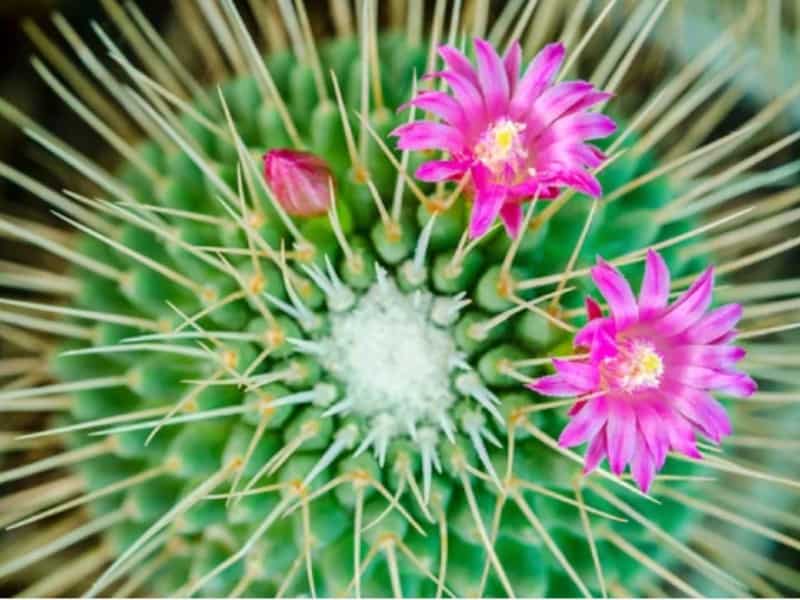
One of the great things about the species within the genus Notocactus, now known as Parodia, is that they are incredibly easy to care for. As with most cactus, Notocactus members prefer a hands-off approach to their care and seem to thrive on neglect.
Light
The amount of light your Notocactus needs will depend on the species. A few species enjoy full sun, while most would rather have some shade during the hottest hours of the afternoon.
If your climate allows, this genus of cacti will thrive when grown outdoors. For most gardeners, placing the cacti in containers allows them to move the plants around to get just the right amount of light.
If your Notocactus is exposed to too much direct light, it may become sunburned. If you begin noticing patches of discoloration, usually black or brown depending on severity, it’s time to reduce the amount of direct light your cactus is receiving.
No products found.
However, you must be careful that your Notocactus is getting enough light. These are not great plants for low light environments and may become stretched out, or etiolated, if they aren’t getting a satisfactory amount of light each day.
Water
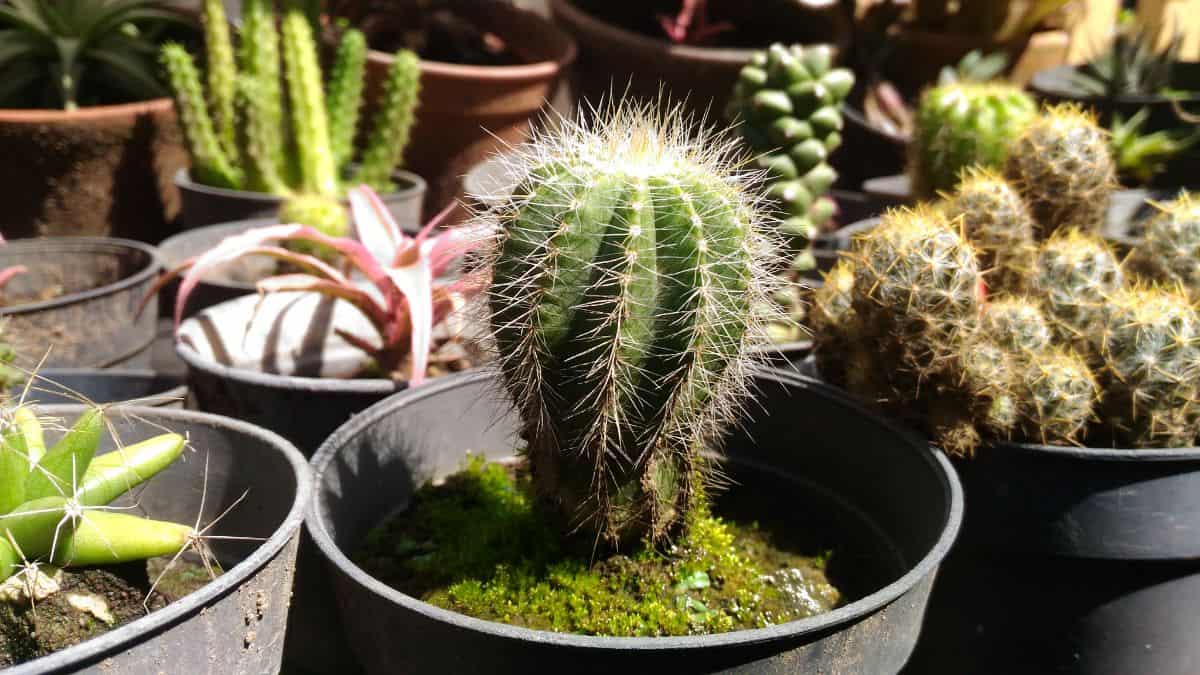
Like most cacti, members of the Parodia (Notocactus) genus do not appreciate excessive moisture. These plants are incredibly sensitive to overwatering and will rot if they are watered too frequently.
To prevent accidental overwatering, it’s crucial that you check the soil moisture level before you water each and every time. This can be accomplished by using your finger or a soil moisture meter inserted into the soil near your cactus’ base.
If the soil is moist, you’ll need to wait for it to dry out before watering. If the soil feels dry, you can thoroughly soak the soil before allowing it to dry out again once more.
This method of watering is known as the “Soak and Dry” method because you give the plant as much water as the soil can possibly absorb and then leave it to completely dry out before watering again.
This genus tends to be especially sensitive to moisture during the winter, so it’s recommended to keep the roots quite dry until spring. Once the cactus begins actively growing again, you can resume a normal watering schedule.
Unfortunately, if you do end up overwatering your cactus, you may not be able to notice before it’s too late. Root rot has a habit of advancing quickly and by the time you notice signs of rot in your cactus, it may be too late to save it.
This is why it’s so important to use proper soil and containers, as well as an appropriate watering schedule, to allow excess water to escape and give the roots a chance to dry out between watering.
Temperature
Parodia, or Notocactus, is not a genus of frost-tolerant cacti. These cacti prefer warmer temperatures and tend to suffer in climates where winters are frigid.
If you’re attempting to grow this cactus outdoors, be ready to bring it indoors when temperatures dip below freezing. If you live in a climate with mild winters, you may be able to leave the cactus outdoors year-round but be prepared to cover it on the rare occasion that it gets too cold.
These cacti tend to do well indoors where temperatures are more stable as seasons change. However, it’s still recommended to keep them away from doors to the outside or windows that are frequently opened to protect them from sudden changes in temperature.
Soil
As with most species of cacti, members of the Notocactus genus prefer soil that drains quickly. In their natural habitat, these cacti tend to grow in gritty, rocky areas.
When grown in cultivation, it’s recommended to either mix your own soil or use a commercial soil mix formulated for cacti and succulents. Cactus soil tends to contain ingredients with larger particles to encourage better drainage and airflow around the roots.
When shopping for soil, look for a mix containing matter such as coarse sand, perlite, gravel, and even pumice. Avoid soil containing water retaining ingredients like clay, peat moss, or coconut coir. Small amounts of these ingredients are fine, but too much may cause your cactus to rot.
It’s also important to note that you should avoid lining the bottom of your pot with rocks to encourage better drainage. Though this method is often recommended, it actually has the opposite effect and can result in accidental overwatering.
The reason for this is that water likes to stick to itself, so rather than running down through the rocks, water molecules stay suspended in the soil. This creates a perched water table, which brings the water closer to your cactus’ roots, potentially exposing it to an excessive amount of moisture.
Container
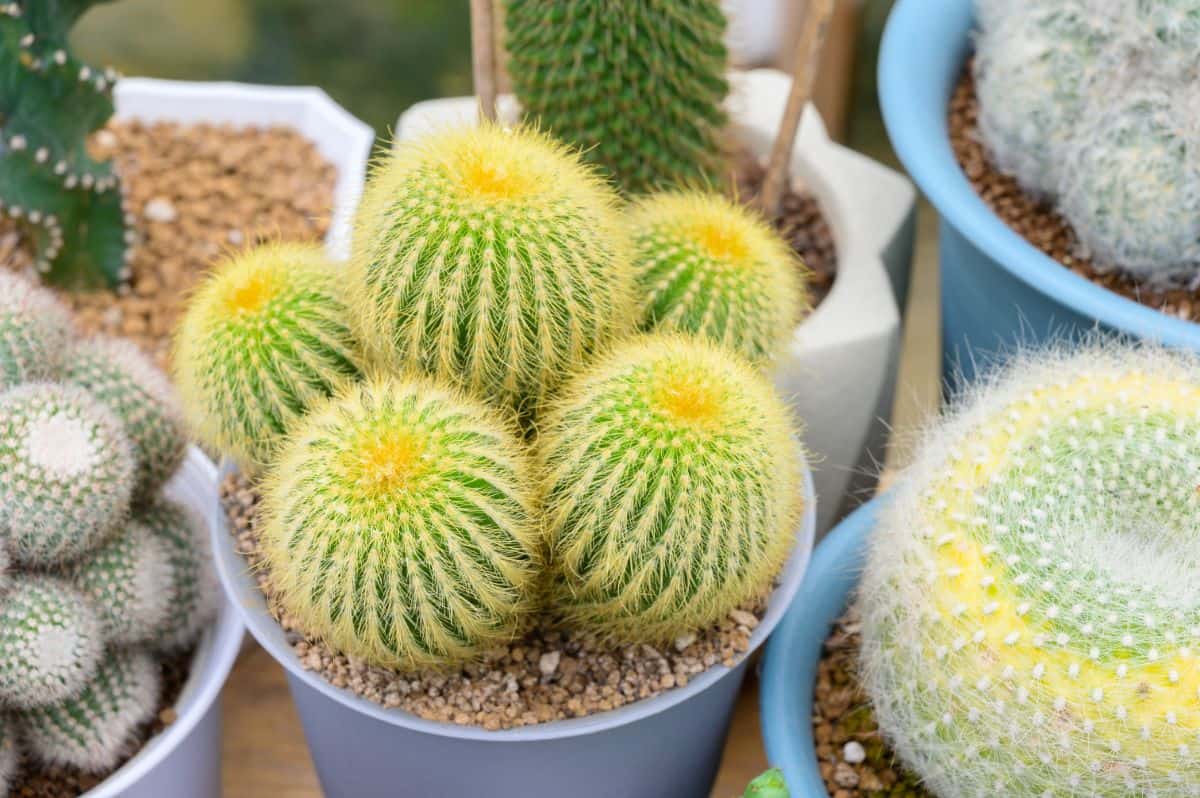
As with any species of cactus or succulent, drainage is the most important aspect of choosing a container for your Notocactus. This is not a plant that would do well in a container lacking in drainage holes as they can be very sensitive to overwatering.
If you’re determined to use a pot without a drainage hole, consider using a nursery pot inside the holeless pot. If you have the tools and skills to do so, you might also consider just drilling a hole in the pot.
The material your pot of choice is made of will also influence your watering habits, so it’s important to choose wisely.
Terracotta pots tend to absorb excess water from the soil. This can be helpful if you’re prone to overwatering, but it means you’ll likely have to water more frequently during hot, dry weather.
Plastic or glazed ceramic pots will not absorb excess water, so you’ll need to plan your watering schedule accordingly and be a bit more careful about your watering habits.
Propagating Notocactus
If you’d like more cacti in your collection or wish to share them with family and friends, Notocactus propagation is relatively easy for gardeners of any skill level. There are three methods of propagation that can be used: separating offsets, cuttings, and seeds.
When propagating Notocactus, it’s important to handle the cacti carefully to prevent injury. Their spines are sharp, so be sure to wear thick gloves or use newspaper, towels, or a small piece of carpet to create a protective layer between your hands the cactus spines.
Offsets
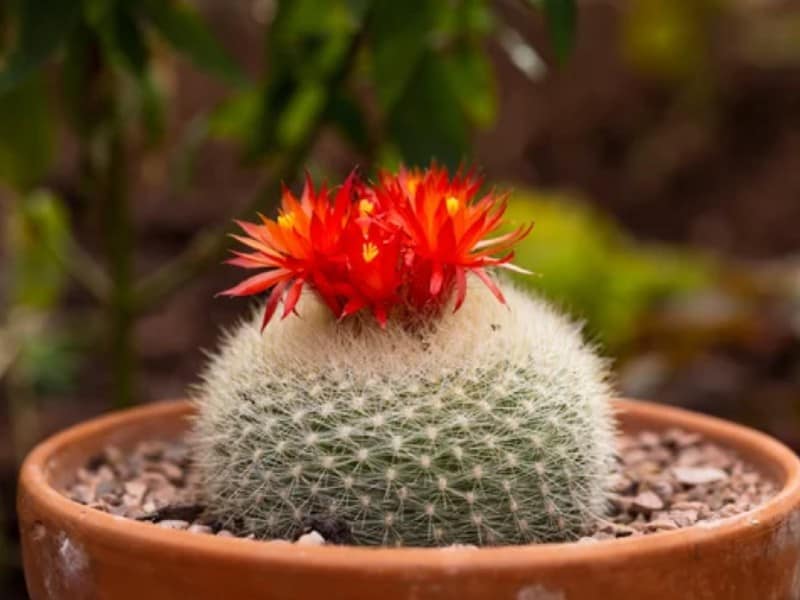
Separating offsets is by far the easiest method of Notocactus propagation. Many species of Notocactus produce offsets, or pups, around their base that can be easily removed and transplanted into their own containers.
This method is particularly simple because nature has done most of the work for you. These tiny cacti already have functional root systems and just need to be given their own space.
Offsets can be removed using your fingers or a sharp knife. It can be helpful to brush away the top layer of soil so that you can see the roots better. Try to separate the offset as close to the mother plant as possible to give it as many roots as possible.
Once removed, you’ll need to give the offsets a few days to callous before planting. This helps prevent any potential infection once the plants are introduced to new soil. Otherwise, that wound is an open doorway for bacteria and fungus to enter and take hold.
After the offsets have calloused, they’re ready to be planted in cactus-approved soil. At this point, they can be treated exactly like a mature Notocactus.
Cuttings
Since most species of Notocactus are globose or columnar, cuttings are not the most common method of propagation. However, if your cactus’ roots have begun to rot, or part of the plant has been sunburned, beheading the cactus and propagating it can be a great way to save it from further damage.
Cuttings must be taken with sharp, sterile scissors or shears to ensure a clean cut. Be sure to take only healthy areas of the cactus as cuttings to boost your chances of success.
As with offsets, your cuttings will need to dry for a few days before planting to give them time to callous. Try to keep them out of direct sunlight during this time as it may damage your plant during this stressful period.
Once calloused, you can dip the cut end of your cutting into rooting hormone powder if you wish. Though this step isn’t required for successful propagation, many gardeners believe it will hasten rooting.
Next, you’re ready to place the cutting, cut end down, into well-draining soil. It’s recommended to water sparingly for the first few weeks until your cactus has started to produce tiny roots.
As the roots develop, you’ll be able to treat the Notocactus more like a mature plant and return to a normal watering schedule.
Seeds
The final method of Notocactus propagation is also the least frequently used method. This is because Notocactus are slow-growing cacti and can take quite a long time to mature. Growing a cactus from seed is not a good method for impatient gardeners, but it can be a fun experiment and test of your cactus gardening skills.
If you already have Notocactus species in your current collection, you can try collecting seeds yourself after they’ve bloomed and been pollinated. Otherwise, you’ll need to purchase the seeds.
Reputable seed vendors can easily be found online. There are many vendors that specialize in cacti and succulents and have the seeds of even the rarest varieties available.
Once you have the seeds in hand, it’s time to sow them. You’ll want to use the same cactus-approved soil you’d use with a mature Notocactus.
It’s recommended to plant the seeds in either a seed tray or pot, depending on your preferences. Since these cacti grow slowly, some gardeners use a pot so that they don’t have to have the unattractive view of a seed tray until the seedlings are large enough to be safely moved to another container.
Whatever container you choose, make sure your soil is moist and sprinkle the seeds across the surface of the soil. You can sprinkle a bit of soil on top of the seeds, but make sure you don’t bury them too deeply.
The soil will need to be kept moist, but not overly wet to prevent the seeds from rotting. Some gardeners, especially those in dry climates, use a sheet of plastic or glass to cover the container to help retain a bit of moisture.
After a few weeks, you should begin to see tiny green specks sprouting from the soil. These specks are your Notocactus seedlings. At this point, you should be able to safely remove the cover and begin treating them more like mature cacti.


